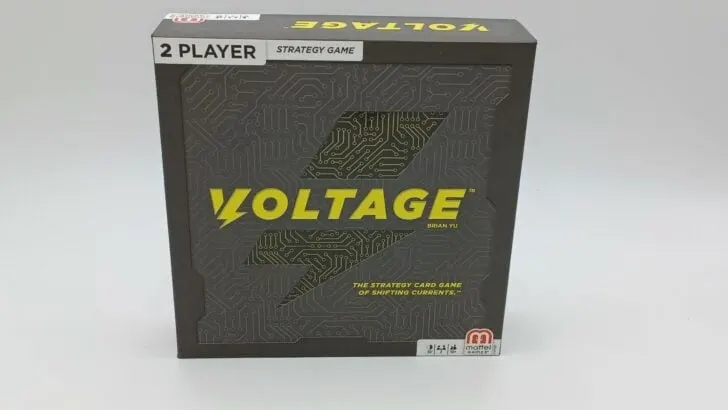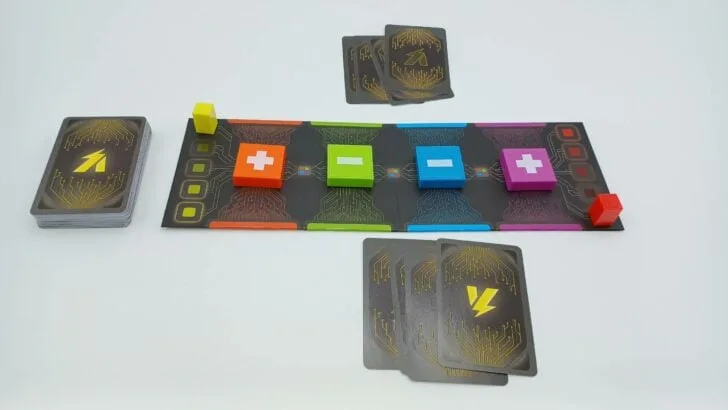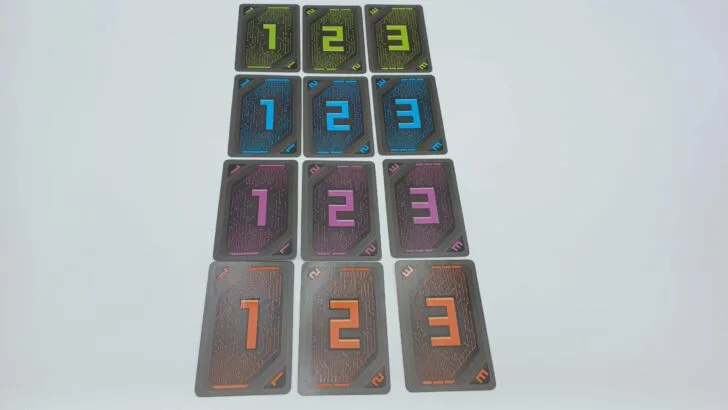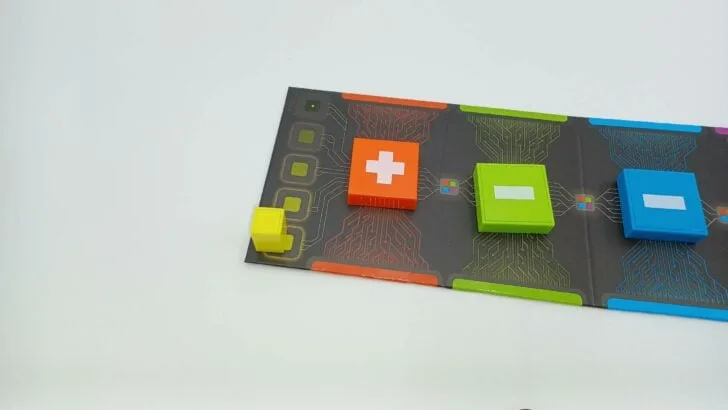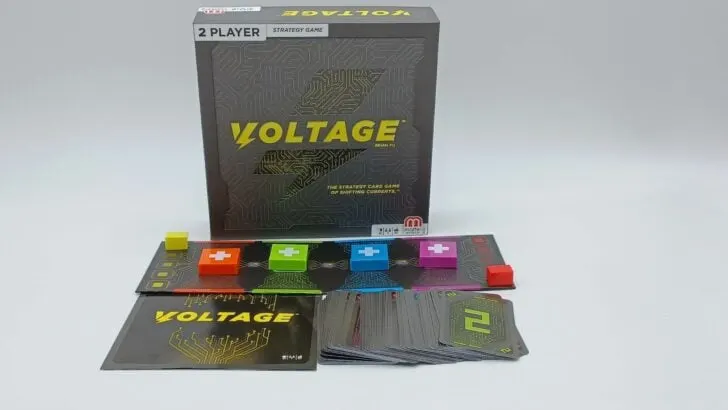Voltage How to Play Quick Links: Objective | Setup | Playing the Game | Card Meanings | Winning Sets | Winning the Game | FAQ | Components
Objective of Voltage
The goal of Voltage is to be the first player to reach the end of the score track by winning four sets of cards.
Setup
Put the game board in the middle of the table or playing area. Place the four terminal blocks on their color squares on the game board. To begin the game, set the orange and purple blocks to the + side. Set the green and blue blocks to the – side. Place the yellow and red score markers on the corresponding score track (put them on the two squares that just show a small dot on them). Decide which player will play as each color. Shuffle all of the cards together and deal four cards to both players. Then place the deck of cards by the game board to serve as a draw pile. You will also need room for a discard pile as well.
Playing Voltage
Overview of Voltage
Both players will be placing cards on either side of the board. They can play them to their side of the board or their opponent’s. Whenever five cards are played to the same terminal (color), that set is scored with the highest (or lowest) scoring player winning it. There are also special cards that can affect who wins the set.
Players should always have an even number of cards in their hand at all times. If the draw pile runs out of cards, reshuffle the discard pile to make a new draw pile.
Turn Actions
The oldest player gets to start first in Voltage. They must do one, and only one, of the the following three actions on their turn:
- Play a card, then draw a card (in that exact order).
- Play two cards to two different color terminals.
- Draw two cards. If you already have six cards in your hand, you cannot choose this action since you can never have more than six cards in your hand at any point during your turn.
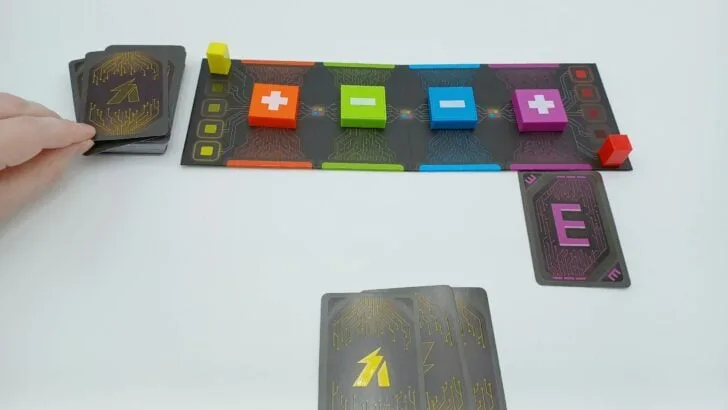
This player has decided to take the “play a card then draw a card” action. They place the purple 3 on their side of the board and draw a card. Option 3 is similar but instead of playing a card, they could elect to draw two cards instead.
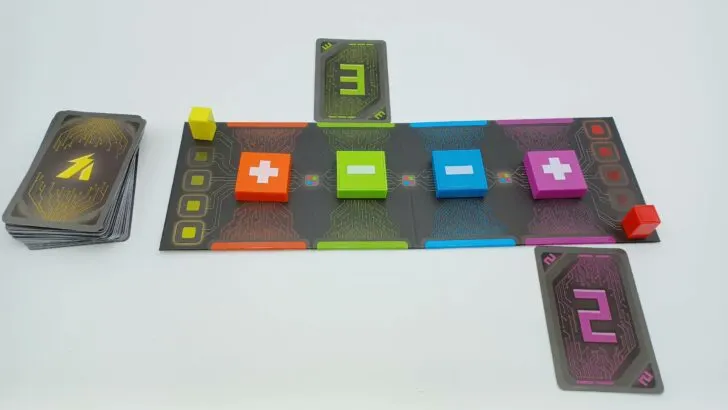
This player has chosen to play two cards. They must play two different colors so they play the purple two on their side of the board and the green three on their opponent’s side (since that side is currently a -).
Playing Cards
Whenever a player decides to play cards, they must play it to the matching color terminal (a blue card must be played to the blue terminal, etc.). Since bypass and blown fuse cards have no color they can be played to any color terminal the player wishes. You can choose to play your cards on your side or your opponent’s side of the terminal.
Drawing Cards
In most cases, simply draw your card(s) and nothing else happens. However, if you draw one of the 18 cards with a yellow “V” on the card back you have drawn a transformer card and must take a special action. See the transformer cards section below for more details.
Voltage Card Meanings
Number Cards
These cards are all numbered 1, 2, or 3. They must be played to their color’s corresponding terminal (on either your side or your opponents).
Bypass Cards (aka Swap Cards)
These cards can be played on any color but must be played on your opponent’s side of the terminal. They allow you to take any number card from your opponent’s side and add it to your side instead. You may not use it to move one of your cards over to your opponent’s side of the board. The bypass card then stays in place and still counts towards the terminal’s five cards (it counts as 0 points). If it is the fifth card on that terminal, the set will be scored. Presumably you still take one of your opponent’s cards and switch it to your side before scoring but the rules are not clear on this issue.
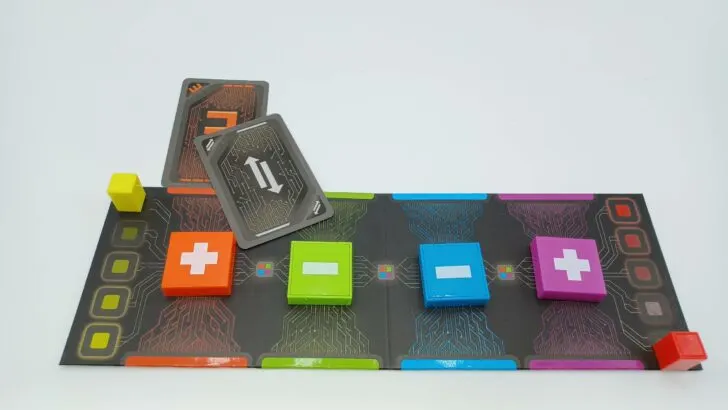
This player has played a bypass card on his opponent. They may take the orange three card and move it to their side. They will then place the bypass card in its place.
Blown Fuse Cards (aka Remove Cards)
You can play blown fuse cards on any color terminal. Like bypass cards they can only played on your opponent’s side of the terminal. When you play a blown fuse card, take one of your opponent’s cards on that side of that terminal, discard it to the discard pile, and place the blown fuse card in its place. You may not use this card to remove a card from your own side of the board. The blown fuse card counts towards the five cards needed to score the terminal and counts as 0 points.
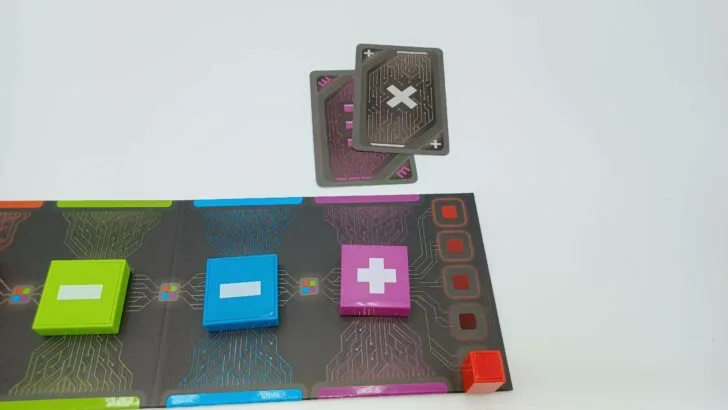
This player has played a blown fuse card on their opponent. They will discard their opponent’s purple three card and replace it with the blown fuse card.
Transformer Cards
These cards can be identified by the yellow “V” on their card backs. The front of their cards will be normal (either a number card, bypass, or blown fuse). When a player draws them they must flip over any of the four terminal blocks on the board. They must flip a + to a – or vice versa. Once the cards are drawn they no longer affect the terminal blocks, even when played to a terminal.
If a player is dealt one or more transformer cards at the beginning of the game, ignore them and don’t change any terminal blocks. If a player draws two transformer cards during the same turn, they must change two terminal blocks. They may flip the same terminal block twice if they wish (to keep it the same as it was at the start of the turn).
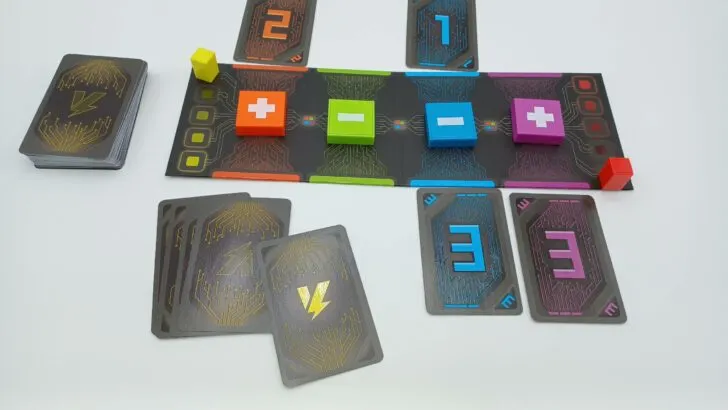
This player has drawn a transformer card (notice the yellow V on the card back). They must flip one of the terminal blocks to the other side. In this case, it might be a good idea to change the blue terminal block to a + since they currently have more points than their opponent.
End of Turn
After a player has chosen and completed their action for the turn, the other player takes their turn. Continue alternating turns until one player wins the game.
Winning Sets in Voltage
Whenever five cards have been played to a single color terminal, it will be scored. Both sides of the board count towards this five card limit and any combination (three on your side and two on your opponent’s, four on your opponent’s and one one yours, etc.) will cause the terminal to be scored. Bypass and blown fuse cards count towards the five cards as well. Whenever the five card limit per terminal is reached, a set is declared immediately and no other moves can be made until you score the set.
Scoring + Sets
Players add up the card numbers on their side of the terminal (bypass and blown fuse cards count as 0). If the terminal block is on the + side, the player with the highest total wins the set.
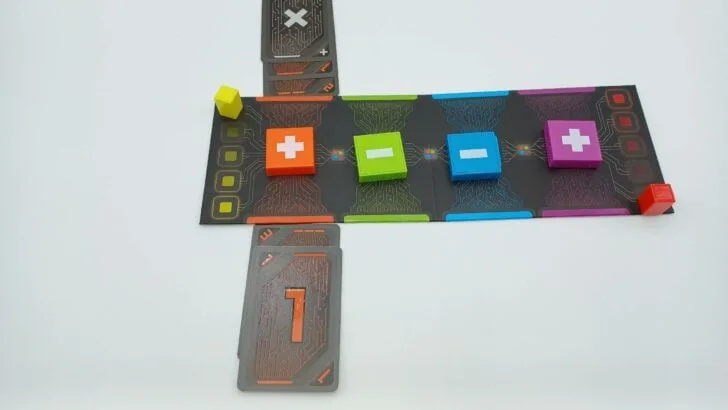
Five cards have been played to the orange terminal so it is time to score it. The terminal block shows a “+” so the highest score wins the set. In this case the player closer to the camera has four points compared to their opponent’s three so they win the set.
Scoring – Sets
When the terminal block is on the – side, the player with the lowest total wins the set.
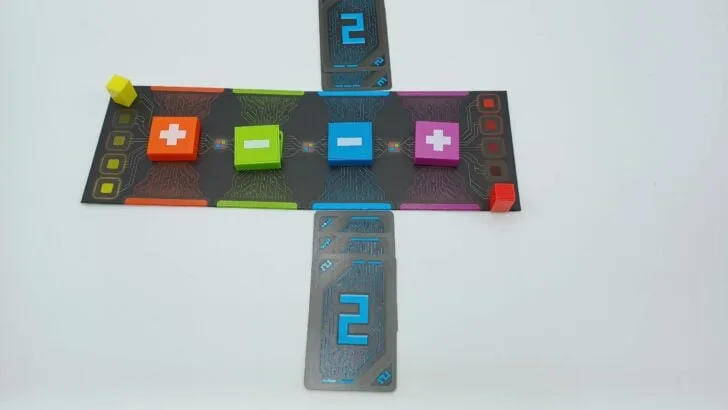
The blue terminal has reached the five card limit and is set to -. The player with the lowest score wins this set.
Tiebreaker and Rewards
If there is a tie, the player who played the fifth card loses the tiebreaker and thus the set.
The player that won the set moves their score marker up one spot on the scoring track. Discard the cards used to make the set and resume play as normal. If a player still has part of an action to take, they still take it. For example, if they chose the first action (play a card, then draw a card), they still get to draw their card.
Winning Voltage
The first player to win four sets (reach the end of their score track) wins Voltage.
Voltage FAQ
Note: If you have any questions about how to play Voltage, leave a comment below on this post. I will try to answer any questions asked as best and as quickly as possible.
Components
- 1 game board
- 56 cards
- 12 orange cards numbered 1-3
- 12 green cards numbered 1-3
- 12 blue cards numbered 1-3
- 12 purple cards numbered 1-3
- 4 bypass cards
- 4 blown fuse cards
- 4 terminal tokens (orange, green, blue, purple)
- 2 score markers (red, yellow)
- rules
Year: 2006 (second edition released in 2018) | Publisher: Mattel | Designer: Brian Yu
Genres: Card Game, Hand Management, Pattern Building
Ages: 10+ | Number of Players: 2 | Length of Game: 30 minutes
Where to Purchase: Amazon, eBay – Any purchases made through these links (including other products) help keep Geeky Hobbies running. Thank you for your support.
For more board and card game how to plays/rules and reviews, check out our complete alphabetical list of board game posts.

